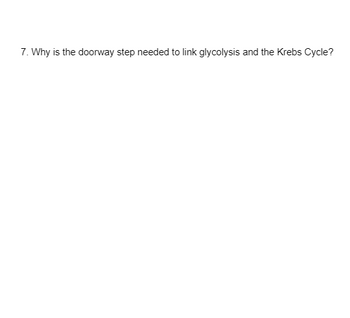
Biochemistry
9th Edition
ISBN: 9781319114671
Author: Lubert Stryer, Jeremy M. Berg, John L. Tymoczko, Gregory J. Gatto Jr.
Publisher: W. H. Freeman
expand_more
expand_more
format_list_bulleted
Question

Transcribed Image Text:7. Why is the doorway step needed to link glycolysis and the Krebs Cycle?
Expert Solution
This question has been solved!
Explore an expertly crafted, step-by-step solution for a thorough understanding of key concepts.
This is a popular solution
Trending nowThis is a popular solution!
Step by stepSolved in 2 steps

Knowledge Booster
Similar questions
- How is a “committed step” defined in the context of a metabolic pathway and why are they important? Which steps and/or enzymes are involved in the committed steps in the Krebs Cycle? What are the possible implications of these steps were deregulated?arrow_forwardClassify the following enzymes: Oxidoreductase, Hydrolase, Transferase, Lyase, Ligase, Isomerase 1. Sucrase - 2. Trypsin - 3. Catalase - 4. Aspartate aminotransferase - 5. Cellulase - 6. Ptyalin - 7. Lactase - 8. Creatinine phosphokinase - 9. 5- alpha reductase - 10. Aminopeptidase -arrow_forward1. Draw and label a diagram that shows the organization of the glycolysis, Kreb's Cycle, and oxidative phosphorylation within the cell.arrow_forward
- 4. Pyruvate is the end-product of glycolysis. Many organisms, such as anaerobic bacteria, can only produce energy (ATP) by glycolysis, therefore, pyruvate has no more potential for ATP generation for these organisms. Rather than simply excrete pyruvate, this molecule is changed to another molecule such as lactate. In these organisms, why do you think pyruvate is changed to lactate and then excreted, rather than simply excreted?arrow_forward1. What are hydrolase and lyase? 2. What is ligase and transferase? 3. What is isomerase and oxidoreductasearrow_forwardDescribe how a) Mean Arterial Pressure, b) Maximal Oxygen Consumption, and c) Blood Flow are determined using its formula. In addition, you should explain what those factors are including cardiac output, stroke volume, heart rate, resistance, a-vO2 difference, etc. Describe how many ATPs can be generated by complete cycles of beta oxidation of free fatty acid with 20 carbons. You should indicate how many cycles of beta oxidation and Krebs cycle, and total number of products as wellarrow_forward
- 1. Write out the mechanism of TIM-catalyzed reaction in the direction it goes in glycolysis. Show involved enzymatic residues.arrow_forwardname the remaining 4 carbon molecules of the TCA cycle?arrow_forward1. Why is the chemical logic behind the phosphorylation of glucose by hexokinase? a. So that we end the preparatory phase with 2 3-carbon compounds. b. to provide a substrate for phosphohexose isomerase. c. "Locks" Glucose in the cell. d. to decrease the ΔG of the next reaction. 2. What type of reaction does glyceraldehyde-3-phosphate dehydrogenase catalyze? a. isomerization b. group transfer c. oxidation d. dehydrationarrow_forward
- 1. Name the phosphate-modifying enzyme that turns off glycogenolysis and turns on glycogenolysis. 2. Which enzyme uses UDP-glucose to build into straight chains of glucose on a glycogen core?arrow_forward10. The first reaction in glycolysis is the phosphorylation of glucose: Pi + Glucose → Glucose-6-phosphate This is a thermodynamically unfavorable process with AGº = +13.8 kJ/mol. In a liver cell at 37 °C the concentration of both phosphate and glucose are normally maintained at about 5 mM each. The equilibrium concentration of glucose-6-phosphate according to the above data is: A. 1.18 x107 B. 8.50 x 104 C. 4.25 x 105 D. 2.21 x 10s E. 1.38 x 108 F. 3.02 X 103 G. 6.75 x 10-6 H. 4.08 x 10 I. 9.15 x106arrow_forward23. The substrate used in the LAST step of glycolysis is _____. Select one: a. phosphoenolpyruvate b. pyruvate c. glyceraldehyde-3-phosphate d. 1,3-bisphosphoglyceratearrow_forward
arrow_back_ios
SEE MORE QUESTIONS
arrow_forward_ios
Recommended textbooks for you
 BiochemistryBiochemistryISBN:9781319114671Author:Lubert Stryer, Jeremy M. Berg, John L. Tymoczko, Gregory J. Gatto Jr.Publisher:W. H. Freeman
BiochemistryBiochemistryISBN:9781319114671Author:Lubert Stryer, Jeremy M. Berg, John L. Tymoczko, Gregory J. Gatto Jr.Publisher:W. H. Freeman Lehninger Principles of BiochemistryBiochemistryISBN:9781464126116Author:David L. Nelson, Michael M. CoxPublisher:W. H. Freeman
Lehninger Principles of BiochemistryBiochemistryISBN:9781464126116Author:David L. Nelson, Michael M. CoxPublisher:W. H. Freeman Fundamentals of Biochemistry: Life at the Molecul...BiochemistryISBN:9781118918401Author:Donald Voet, Judith G. Voet, Charlotte W. PrattPublisher:WILEY
Fundamentals of Biochemistry: Life at the Molecul...BiochemistryISBN:9781118918401Author:Donald Voet, Judith G. Voet, Charlotte W. PrattPublisher:WILEY BiochemistryBiochemistryISBN:9781305961135Author:Mary K. Campbell, Shawn O. Farrell, Owen M. McDougalPublisher:Cengage Learning
BiochemistryBiochemistryISBN:9781305961135Author:Mary K. Campbell, Shawn O. Farrell, Owen M. McDougalPublisher:Cengage Learning BiochemistryBiochemistryISBN:9781305577206Author:Reginald H. Garrett, Charles M. GrishamPublisher:Cengage Learning
BiochemistryBiochemistryISBN:9781305577206Author:Reginald H. Garrett, Charles M. GrishamPublisher:Cengage Learning Fundamentals of General, Organic, and Biological ...BiochemistryISBN:9780134015187Author:John E. McMurry, David S. Ballantine, Carl A. Hoeger, Virginia E. PetersonPublisher:PEARSON
Fundamentals of General, Organic, and Biological ...BiochemistryISBN:9780134015187Author:John E. McMurry, David S. Ballantine, Carl A. Hoeger, Virginia E. PetersonPublisher:PEARSON

Biochemistry
Biochemistry
ISBN:9781319114671
Author:Lubert Stryer, Jeremy M. Berg, John L. Tymoczko, Gregory J. Gatto Jr.
Publisher:W. H. Freeman

Lehninger Principles of Biochemistry
Biochemistry
ISBN:9781464126116
Author:David L. Nelson, Michael M. Cox
Publisher:W. H. Freeman

Fundamentals of Biochemistry: Life at the Molecul...
Biochemistry
ISBN:9781118918401
Author:Donald Voet, Judith G. Voet, Charlotte W. Pratt
Publisher:WILEY

Biochemistry
Biochemistry
ISBN:9781305961135
Author:Mary K. Campbell, Shawn O. Farrell, Owen M. McDougal
Publisher:Cengage Learning

Biochemistry
Biochemistry
ISBN:9781305577206
Author:Reginald H. Garrett, Charles M. Grisham
Publisher:Cengage Learning

Fundamentals of General, Organic, and Biological ...
Biochemistry
ISBN:9780134015187
Author:John E. McMurry, David S. Ballantine, Carl A. Hoeger, Virginia E. Peterson
Publisher:PEARSON